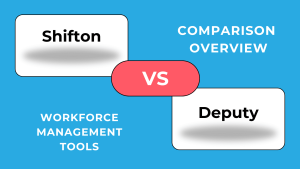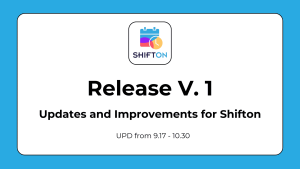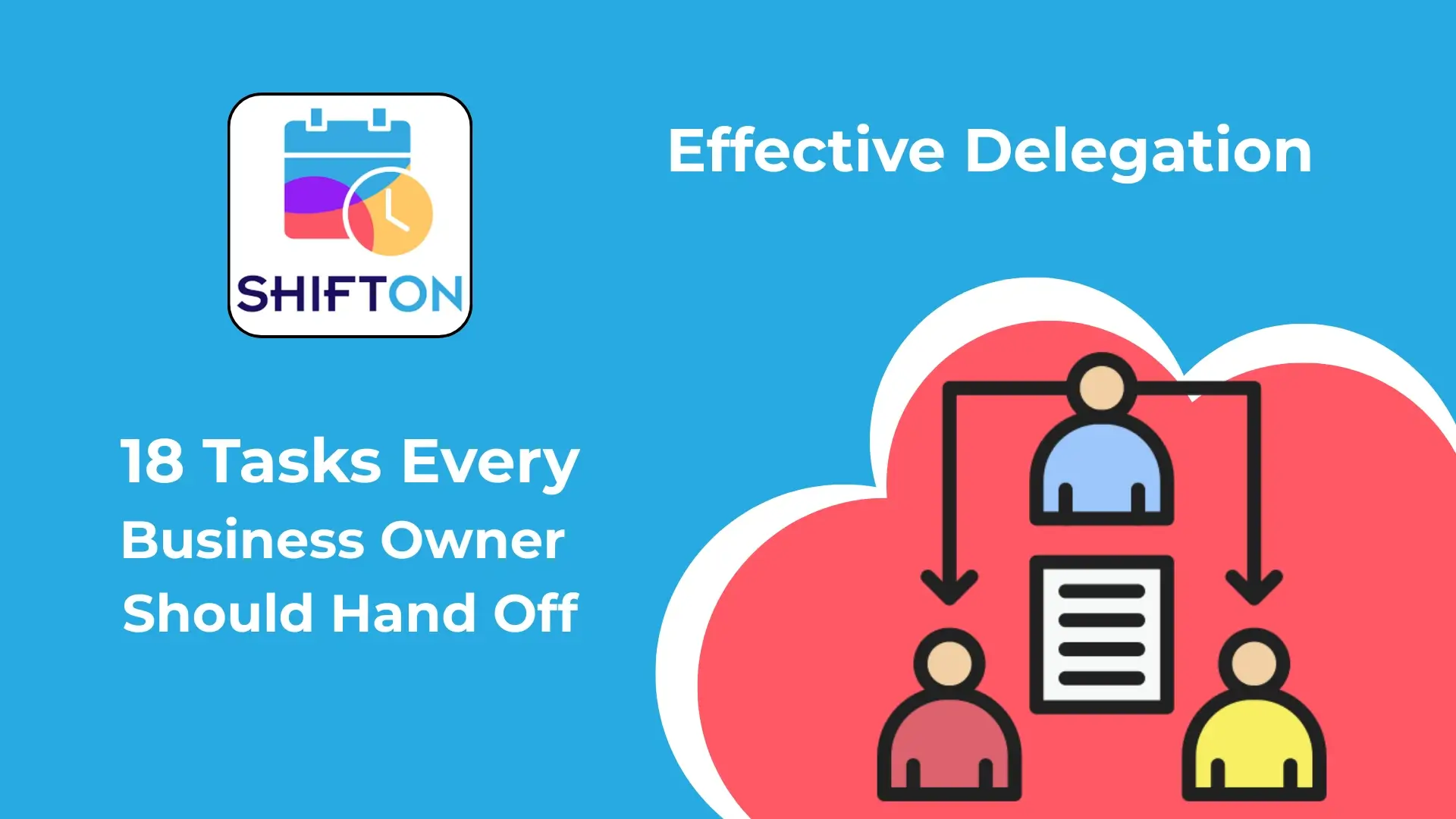Choosing the right kinds of rosters for staff directly affects productivity, job satisfaction, and business efficiency. A well-structured work roster ensures proper staffing, minimises conflicts, and aligns employee availability with company needs. Employers must consider industry demands, operational hours, and worker preferences to determine the best work roster for their team. This guide explores various types of work rosters, including shift-based, flexible, and industry-specific options, helping managers create an optimised roster that supports both business goals and employee well-being.
What Are Work Rosters?
A work roster defines when staff are expected to perform their job duties. It outlines workdays, hours, and shifts, ensuring structured operations. Businesses implement different types of work rosters based on industry requirements, employee contracts, and workload demands.
Some organisations follow a regular work roster, like the standard 9-5 model, while others adopt rotating shifts, compressed workweeks, or fully flexible setups. Choosing the right roster improves efficiency, prevents burnout, and enhances work-life balance.
Work Shift Types
Businesses with extended operating hours or round-the-clock services rely on shift-based work rosters to ensure continuous coverage. Below are the most common shift roster examples used across industries.
| Types | Explanation |
| Work By Shift | Staff are assigned to specific time blocks, ensuring continuous business operations. Common in industries requiring 24/7 coverage, such as healthcare, manufacturing, and security. |
| Double Shift | A work arrangement where staff complete two consecutive shifts with minimal rest between them. Often used in high-demand industries like restaurants and emergency services. |
| Day Shift (1st Shift) | Typically runs from 8 AM to 4 PM or 9 AM to 5 PM. This is the most common work roster for office jobs, retail, and service industries. |
| Evening Shift (2nd Shift) | Covers late afternoon to midnight, such as 4 PM to 12 AM. Common in hospitality, customer support, and healthcare roles. Also known as the “swing shift.” |
| Night Shift (3rd Shift or Graveyard Shift) | Runs overnight, usually 12 AM to 8 AM. Essential for 24-hour operations, including hospitals, law enforcement, and transport services. Night shifts frequently include pay differentials due to the challenging work hours. |
9 Common Shift Rosters for Business
Choosing the right types of rosters ensures efficient operations, staff satisfaction, and compliance with labour laws. Below are the nine most commonly used work roster types across different industries.
#1 Standard
A standard work roster typically follows the 9-5 schedule or 8-5 hours, from Monday to Friday, totalling a 40-hour work week roster example. This is the most traditional setup, typically found in corporate offices, administrative roles, and educational institutions.
Pros:
- Predictable hours, promoting a stable work-life balance.
- Staff know their weekly routine, improving productivity.
- Ideal for roles requiring collaboration and meetings during business hours.
Cons:
- May not suit businesses that require extended operating hours.
- Limited flexibility for staff who prefer alternative rosters.
#2 Fixed
A fixed roster means staff work the same hours every week without variation. This structure is common in retail, manufacturing, and customer service jobs. For example, a retail worker may always work from 10 AM to 6 PM on weekdays.
Pros:
- Predictable shifts improve staff consistency.
- Easier for managers to plan staffing needs.
- Staff can plan personal commitments around work hours.
Cons:
- Less flexibility for both staff and employers.
- It may not accommodate sudden business needs or seasonal fluctuations.
#3 Full-Time
A full-time roster generally consists of 40-hour work week roster examples spread across five or more days. Most full-time positions follow a standard roster, but variations exist depending on industry requirements.
Pros:
- Staff receive full benefits such as health insurance and paid leave.
- Stable income and career growth opportunities.
- Provides consistency in team collaboration.
Cons:
- Longer hours can lead to burnout without proper breaks.
- Less flexibility for staff seeking work-life balance.
#4 Part-Time
A part-time roster consists of fewer hours than a full-time roster, usually under 30 hours per week. These schedules vary and can be flexible based on employer and staff agreements.
Pros:
- Provides flexibility for staff who need a lighter workload.
- Cost-effective for businesses, as part-time workers may not require full benefits.
- Ideal for students, parents, and seasonal workers.
Cons:
- Lack of benefits such as health insurance.
- Income may not be stable.
- Scheduling can be inconsistent, impacting the work-life balance.
#5 Shift
A shift schedule assigns staff to different time slots, covering a 24-hour operational cycle. Industries like healthcare, hospitality, and transport heavily rely on different shift schedules to ensure round-the-clock service.
Types of Shift Work:
- Fixed shifts – Employees work the same shift each day.
- Rotating shifts – Employees alternate between morning, evening, and night shifts.
- Split shifts – Work is divided into two separate periods a day.
Pros:
- Ensures ongoing business operations.
- Provides job opportunities for those preferring non-standard hours.
- Helps businesses handle workload variations efficiently.
Cons:
- Night shifts can negatively affect health due to altered sleep patterns.
- Employees may find inconsistent hours challenging.
#6 Contractor Or Freelancer Schedules
Contractors and freelancers do not follow a typical work schedule. Instead, they work based on deadlines or project-based tasks. These professionals, often in tech, design, and content creation, set their own work hours.
Pros:
- Maximum flexibility for both employers and workers.
- Cost-effective for businesses needing specialised skills for short-term projects.
- No obligation to long-term employment agreements.
Cons:
- Less stability for freelancers who depend on consistent income.
- Employers may find it tricky to manage external teams.
- Communication and coordination can be tough with remote workers in different time zones.
#7 Unpredictable
An unpredictable schedule changes weekly or daily based on business needs. This is common in industries with fluctuating demands, like retail, hospitality, and gig economy jobs. Staff may have varying shifts, making it hard to plan personal commitments.
Pros:
- Offers businesses workforce flexibility.
- Employees can take on shifts based on their availability.
- Useful for handling seasonal or sudden workload spikes.
Cons:
- Lack of stability for staff, making financial planning tough.
- Can lead to job dissatisfaction if shifts often change without notice.
- Harder for managers to maintain a steady team schedule.
#8 Compressed Schedule
A compressed schedule condenses standard work hours into fewer days. The most common example is the 4-10 shift schedule, where staff work four 10-hour days instead of a traditional five-day workweek. Another variation is the 9/80 schedule, where employees work 80 hours over nine days instead of ten.
Pros:
- Gives employees extra days off for personal time.
- Reduces travel time and costs.
- Helps businesses extend operating hours without hiring more staff.
Cons:
- Longer workdays can lead to tiredness and reduced productivity.
- Not suitable for businesses that need daily coverage.
- Can pose challenges in managing customer service or response times.
#9 Rotating Schedule
A rotating schedule moves employees through different time slots over a set period. For example, nurses may work a morning shift for one week, then an evening shift, followed by a night shift.
Types of Rotating Schedules:
- Slow Rotation: Shifts change every few weeks.
- Fast Rotation: Shifts change every few days.
Pros:
- Fairly distributes workload among employees.
- Prevents burnout from repetitive shifts.
- Ensures businesses have coverage at all hours.
Cons:
- Difficult for employees to adjust to changing hours.
- It can disrupt sleep patterns and overall well-being.
- Requires careful scheduling to avoid employee dissatisfaction.
Each type of schedule option comes with unique advantages and challenges. Businesses should carefully evaluate industry demands, employee needs, and operational goals before choosing the best work schedule for their team.
14 Alternative Shift Types
Traditional shift schedules don’t always fit every business model. Many industries require flexibility to accommodate changing workloads, seasonal demand, and employee needs. Below are 14 alternative types of schedules that businesses can implement to optimise operations while supporting work-life balance.
1) Split Shifts
A split shift divides an employee’s workday into two separate segments with a significant break in between. Unlike a standard schedule with a short lunch break, this type of shift often includes a long gap between working hours.
Example:
A restaurant worker may work from 8 AM to 12 PM, take a break, then return from 5 PM to 9 PM to handle peak dinner service.
Pros:
- Allows businesses to staff employees during peak hours while reducing labour costs during slow periods.
- Employees can use long breaks for personal tasks, rest, or even a second job.
- Useful for industries like food service, transportation, and customer service, where demand fluctuates throughout the day.
Cons:
- Extended workdays can feel exhausting despite long breaks.
- Employees may struggle to manage time effectively between shifts.
- Not suitable for workers who prefer a continuous work schedule.
2) Weekend Shifts
Some businesses require staffing on weekends, either to handle customer demand or maintain continuous operations. A weekend shift schedule assigns employees to work on Saturdays and Sundays, often with weekdays off.
Example:
A hotel receptionist may have a Thursday-Monday schedule, with Tuesday and Wednesday as rest days.
Pros:
- Essential for industries like hospitality, healthcare, and retail, which see high weekend traffic.
- Employees who prefer time off on weekdays (e.g., parents, students) benefit from this schedule.
- Often comes with pay incentives or shift differentials.
Cons:
- Employees may feel disconnected from family and friends who work a typical work schedule.
- Weekend shifts can be less desirable, leading to higher turnover.
3) On-Call Shifts
An on-call shift requires employees to be available for work if needed but does not guarantee them set hours. They must remain reachable and prepared to report to work at short notice.
Example:
A doctor may be on-call overnight, ready to come in if a patient emergency arises.
Pros:
- Ensures immediate response to urgent work demands.
- Common in healthcare, IT support, and emergency services, where unpredictable situations arise.
- Employees may receive compensation even if they are not called in.
Cons:
- Unpredictability makes it difficult for employees to plan personal time.
- Constant availability can be stressful and lead to burnout.
- Some labour laws require compensation for on-call status, increasing payroll costs.
4) Overtime Shifts
An overtime shift occurs when an employee works beyond their scheduled hours, often exceeding the standard 40-hour work week schedule example. Overtime is typically compensated at a higher pay rate.
Example:
A factory worker may work 10 extra hours during peak production periods, earning 1.5x their regular pay rate.
Pros:
- Provides employees with opportunities for extra income.
- Helps businesses meet increased demand without hiring additional staff.
- Useful in industries like logistics, healthcare, and manufacturing.
Cons:
- Can lead to employee fatigue and decreased productivity.
- May result in higher payroll costs.
- Long-term reliance on overtime can indicate poor workforce planning.
5) Flexible Shifts
A flexible shift allows employees to set their own work hours within a given framework. Instead of adhering to a standard schedule, they can start and end work at different times based on personal preference and job requirements.
Example:
A software developer may choose to work from 7 AM to 3 PM instead of the traditional 9-5 schedule.
Pros:
- Improves work-life balance, reducing employee stress.
- Increases productivity by allowing employees to work during their most productive hours.
- Helps attract top talent, especially among remote workers and knowledge-based industries.
Cons:
- Requires trust between employers and employees to ensure the work gets done.
- Can create difficulties in coordinating team meetings and collaboration.
- Not suitable for industries needing strict shift coverage, such as healthcare or retail.
6) Seasonal or Temporary Shifts
A seasonal shift schedule assigns employees work only during specific times of the year, typically in industries with fluctuating demand. Temporary shifts might be used for special projects or short-term employment.
Example:
Retail workers hired for Black Friday and the Christmas season or agricultural workers brought in during harvest months.
Pros:
- Helps businesses manage peak demand efficiently.
- Provides job opportunities for temporary workers.
- Reduces costs associated with hiring full-time staff.
Cons:
- Seasonal workers might require extensive training, increasing onboarding time.
- Temporary employment lacks stability, leading to high turnover.
- Businesses must rehire and train new employees each season.
7) Irregular Shift Schedule
An irregular shift schedule changes frequently, with no set pattern. Employees may work different hours each week based on business needs.
Example:
A bartender might work Monday evening one week, then Saturday morning the next.
Pros:
- Offers businesses maximum scheduling flexibility.
- Useful for covering unexpected absences or workload changes.
- Helps optimise staffing levels without overstaffing.
Cons:
- Makes personal planning difficult for employees.
- Can cause fatigue due to inconsistent sleep patterns.
- High unpredictability can lead to employee dissatisfaction.
8) No Set Schedule
A no set schedule means employees do not have predetermined work hours or shifts. Instead, they work on an as-needed basis, often with short notice. This type of work schedule is common in the gig economy, freelance jobs, and some retail or hospitality positions.
Example:
A rideshare driver logs into an app whenever they are available to accept rides. A freelance graphic designer picks up projects based on demand.
Pros:
- Maximum flexibility for workers who prefer choosing their own hours.
- Useful for businesses with unpredictable workloads.
- Reduces the need for scheduling oversight.
Cons:
- Employees may struggle with income instability due to fluctuating hours.
- Harder for businesses to ensure consistent staffing.
- Workers may be unable to plan personal time effectively.
9) Pitman Shift Schedule
The Pitman shift schedule is a rotational system often used in industries requiring 24/7 coverage. Employees work two or three 12-hour shifts in a row, followed by days off. The cycle typically repeats every two weeks.
Example:
A security guard works Monday and Tuesday (12-hour shifts), has Wednesday and Thursday off, then works Friday to Sunday. The following week, the pattern reverses.
Pros:
- Provides every employee a full weekend off every other week.
- Reduces commute frequency since employees work longer shifts.
- Employees have multiple days off in a row, allowing for recovery.
Cons:
- 12-hour shifts can be physically and mentally exhausting.
- May not suit workers who prefer a traditional 40-hour work week schedule.
- Scheduling errors can cause coverage gaps.
10) Dupont Shift Schedule
The Dupont shift schedule is a four-week cycle where employees rotate between day and night shifts with built-in rest days. This schedule provides a full week off every four weeks.
Example:
A manufacturing plant follows this cycle:
- Four night shifts → Three days off
- Three day shifts → One day off
- Three night shifts → Three days off
- Four day shifts → Seven days off
Pros:
- Ensures continuous business operations whilst giving employees extended rest periods.
- Provides one full week off every month, improving work-life balance.
- Fairly distributes night and day shifts amongst all employees.
Cons:
- The rotation between night and day shifts can disrupt sleep patterns.
- Extended work hours may lead to burnout.
- Requires precise scheduling to prevent understaffing.
11) Kelly Shift
The Kelly shift schedule is commonly used in fire departments and emergency services. It follows a 9-day cycle where employees work 24-hour shifts, followed by 48 hours off.
Example:
A firefighter works Monday (24 hours), then has Tuesday and Wednesday off before working another 24-hour shift on Thursday.
Pros:
- Provides long rest periods after each shift, allowing for recovery.
- Helps maintain 24/7 staffing coverage without excessive overtime.
- Fewer commuting days per month, reducing travel costs.
Cons:
- 24-hour shifts are physically and mentally demanding.
- Not suitable for roles requiring constant mental alertness.
- Employees may experience sleep deprivation during shifts.
12) 2-2-3 Shift Schedule
The 2-2-3 shift schedule, also known as the Panama schedule, operates on a rotating basis with two days on, two days off, three days on. Employees work 12-hour shifts, ensuring 24/7 business coverage.
Example:
Week 1: Monday-Tuesday (work), Wednesday-Thursday (off), Friday-Sunday (work)
Week 2: Monday-Tuesday (off), Wednesday-Thursday (work), Friday-Sunday (off)
Pros:
- Employees never work more than three days in a row.
- Ensures every employee gets a weekend off every other week.
- Maintains fair distribution of work hours across teams.
Cons:
- Employees must adjust to working weekends every other week.
- 12-hour shifts can be tiring over time.
13) 4-10 Shift Schedule
A 4-10 shift schedule allows employees to work four 10-hour days instead of five 8-hour days, providing an extra day off each week.
Example:
An IT specialist works Monday-Thursday from 7 AM to 5 PM and has Friday-Sunday off.
Pros:
- Employees get an extra day off, improving work-life balance.
- Fewer commutes reduce transportation costs and time.
- Longer shifts mean fewer shift changes, improving workflow.
Cons:
- Longer daily shifts can lead to exhaustion.
- Not suitable for businesses requiring coverage five days a week.
14) 9/80
The 9/80 schedule is a compressed workweek where employees work 80 hours over nine days instead of ten, resulting in an extra day off every two weeks.
Example:
- Week One: Four 9-hour shifts (Monday-Thursday), one 8-hour shift (Friday)
- Week Two: Four 9-hour shifts (Monday-Thursday), Friday off
Pros:
- Provides a three-day weekend every two weeks.
- Employees work slightly longer shifts but maintain a regular routine.
- Common in engineering, government, and corporate environments.
Cons:
- Scheduling requires careful tracking of weekly hours to comply with labour laws.
- Employees must adapt to longer workdays without burnout.
Other Work Schedules
Some businesses require non-traditional scheduling methods to balance operational efficiency with employee needs. Below are several additional types of schedules that offer flexibility and adaptability in today’s workforce.
#1 Remote Work Schedule
A remote work schedule lets employees work from home or any place outside the office. This setup has become popular due to tech advancements and the rise of digital collaboration tools.
Example:
A marketing consultant works from home and sets their own hours, provided they meet deadlines and attend virtual meetings.
Pros:
- Boosts employee productivity by minimising office distractions.
- Cuts out commute time, improving work-life balance.
- Broadens hiring opportunities beyond geographical limits.
Cons:
- Needs strong self-discipline and time management skills.
- Collaboration might be tricky without face-to-face interactions.
- Employers need to invest in remote work security and communication tools.
#2 Hybrid Work Schedule
A hybrid work schedule mixes in-office and remote work, letting employees divide their time between both settings.
Example:
An accountant works in the office on Monday and Wednesday, but works remotely on Tuesday, Thursday, and Friday.
Pros:
- Offers flexibility while enabling in-person collaboration.
- Cuts office costs and allows better space use.
- Gives employees more control over their work setting.
Cons:
- Scheduling office days can be tough for team coordination.
- Workers may struggle with keeping a consistent routine.
- Needs reliable tech for smooth communication.
#3 Job Sharing
Job sharing happens when two employees split the duties of one full-time role. Each person takes on a share of the workload, typically working part-time hours.
Example:
Two HR specialists share one role — one works Monday-Wednesday, while the other works Thursday-Friday.
Pros:
- Allows businesses to keep experienced staff needing reduced hours.
- Helps staff maintain work-life balance while keeping their careers.
- Increases workplace diversity by catering to different needs.
Cons:
- Needs flawless communication between job-sharing workers.
- Can cause confusion if tasks and roles aren’t clearly defined.
- Scheduling needs careful management to prevent work disruptions.
#4 Zero-Hours Contracts
A zero-hours contract means an employer isn’t required to provide a set number of working hours, and the employee isn’t obliged to take on work when offered. This type of work schedule is common in hospitality, retail, and event jobs.
Example:
A restaurant worker is called in only when demand is high but doesn’t have guaranteed shifts each week.
Pros:
- Gives businesses a flexible workforce during peak times.
- Lets employees agree to or decline shifts based on availability.
- Lowers payroll costs when business demand is down.
Cons:
- Workers face income instability due to erratic hours.
- Lack of job security can lead to low morale.
- Some countries have strict labour laws regulating zero-hours contracts.
#5 Permanent Part-Time
A permanent part-time schedule offers workers a fixed number of hours each week but below the full-time threshold. Unlike casual or temporary roles, permanent part-time employees receive benefits like paid leave and job security.
Example:
A customer service representative works 25 hours weekly with a set schedule of Monday-Friday, 9 AM – 2 PM.
Pros:
- Offers stability while letting workers maintain reduced hours.
- Helps companies keep skilled staff who prefer part-time roles.
- Workers get benefits while working fewer hours than full-time staff.
Cons:
- Workers might miss out on full-time benefits like career progression opportunities.
- Workload division can be tricky if part-time staff manage crucial tasks.
Shifts By Industry
Work schedules vary depending on the industry’s demands. Some sectors require 24/7 coverage, while others operate during regular business hours. Picking the right types of schedules ensures efficiency, employee satisfaction, and compliance with labour laws.
Work Schedules for Construction
Construction projects follow different types of work schedules depending on deadlines, weather conditions, and labour availability. Many workers operate on 8-5 hours, but some projects require extended or rotating shifts to meet tight timelines. Overtime is common, especially towards project completion. Some construction sites use a 9/80 schedule, where employees work 80 hours over nine days and get every second Friday off.
Workers may also follow a compressed schedule, like four 10-hour shifts, allowing for fewer workdays each week. Seasonal projects often rely on temporary and contractor schedules, where workers are hired for specific phases of construction.
Challenges in construction scheduling include unpredictable weather delays, project changes, and ensuring worker safety during long shifts. Proper scheduling helps maintain efficiency without overworking employees.
Work Schedules for Medical Care Assistants
Healthcare workers require 24/7 shift coverage, leading to highly structured yet demanding schedules. Most hospitals and clinics use rotating schedules, where employees work different shifts each week to balance workloads. Common shifts include:
- Day shift (8 AM – 4 PM)
- Evening shift (4 PM – 12 AM)
- Night shift (12 AM – 8 AM)
Some hospitals implement Pitman or Dupont schedules, ensuring continuous patient care while allowing for extended rest periods. Emergency and ICU staff often follow 12-hour shifts, such as 2-2-3 schedules, where they work two days on, two days off, and three days on.
On-call shifts are common in emergency medicine, requiring staff to be available without a fixed schedule. Overtime is frequent, leading to burnout if not managed properly. Flexible scheduling, job sharing, and remote consultations help reduce strain on medical workers.
Work Schedules for Law Firms
Law firms typically follow a 9-5 schedule, but workloads often extend beyond traditional office hours. Many lawyers work 50-60 hours per week, sometimes including weekends. Junior associates frequently operate on an unpredictable schedule, dictated by client demands and court deadlines.
Some law firms implement compressed schedules, allowing solicitors to work longer hours on fewer days. Remote and hybrid schedules are becoming more common, especially for legal research and client consultations. Paralegals and support staff often work standard schedules, though litigation cases may require overtime.
Balancing workloads in law firms is challenging due to unpredictable case demands. Proper employee work schedule management ensures staff productivity while preventing burnout.
How To Create Employee Work Schedules?
Creating an employee work schedule requires strategic planning to balance business needs with employee availability. A well-structured work schedule improves productivity, reduces conflicts, and ensures smooth operations. Below are key steps to develop an efficient working schedule for employees.
1. Identify Resources
Before creating a schedule, evaluate the resources available, including workforce size, skills, and operational needs. Identify critical roles that require full-time coverage and areas where part-time or contract workers can fill gaps. Consider workload distribution to prevent employee burnout while maintaining business efficiency.
2. List Down Needs for Every Shift Category
Define the number of employees required for each shift and their roles. If the business operates 8-5 hours, ensure sufficient coverage throughout the day. For 24/7 operations, plan shifts like day, evening, and night rotations. Businesses with fluctuating demand should consider seasonal or flexible scheduling.
3. Anticipate Demand
Analyse peak business hours, seasonal trends, and workload variations. Retail stores may need more staff during weekends, while hospitals require consistent 24/7 staffing. Studying past employees’ schedules helps predict future demands and avoid understaffing or overstaffing.
4. Collect Employee Preferences
Consider employee availability and preferences when creating schedules. Some workers may prefer morning shifts, while others perform better during evenings. Gathering input increases job satisfaction and reduces absenteeism.
5. Review Past Schedules
Analyse previous work schedule examples to identify inefficiencies. Look for trends in shift swaps, frequent absenteeism, or scheduling conflicts. Adjust the new schedule to resolve recurring issues and improve workforce management.
6. Create a Plan for Replacement
Unplanned absences can disrupt workflow. Establish a backup plan by maintaining a list of employees available for on-call shifts or overtime. Using a work schedule example with designated backup staff prevents last-minute scheduling problems.
7. Research Laws
Ensure compliance with labour laws and industry regulations. Check rules on scheduled hours, overtime pay, rest breaks, and employee rights. Non-compliance may lead to legal issues and reduced employee satisfaction.
8. Use A Schedule Maker
Manually creating different schedules can be time-consuming and error-prone. Shifton is a task management application designed to automate shift planning, employee scheduling, and workload balancing. With Shifton, businesses can:
- Automate shift assignments based on workload demands.
- Allow employees to request shift swaps and manage availability.
- Reduce scheduling errors with AI-powered optimisation.
- Improve working schedules with real-time adjustments.
Using task management software like Shifton streamlines types of schedule planning, ensuring efficiency and reducing administrative workload.
9. Publish The Schedule
Once the work schedule for employees is finalised, share it with the team in advance. Use task management apps or internal communication tools to notify employees and allow them to review their shifts. Transparency in scheduling prevents last-minute conflicts and improves workforce coordination.
Why Is Creating A Work Schedule Important?
A structured working schedule for employees ensures operational efficiency, workforce satisfaction, and compliance with labour laws. Without a well-organised business schedule, companies face absenteeism, employee burnout, and productivity loss. Below are key reasons why a proper employee work schedule is essential.
1. Improved Employee Retention
A well-planned work schedule for employees reduces stress and ensures fair shift distribution. Employees who receive predictable scheduled hours are less likely to experience burnout or job dissatisfaction, leading to lower turnover rates. Businesses that offer flexible schedule options retain top talent by accommodating personal commitments and work-life balance.
2. Improved Employee Productivity
An optimised work time schedule aligns employee availability with peak business hours, ensuring staff is present when demand is highest. Assigning shifts based on productivity patterns — such as scheduling morning shifts for early risers — maximises efficiency. Employees with a structured working schedule experience fewer distractions and maintain higher performance levels.
3. Guaranteed 24/7 Staffing
Industries like healthcare, customer service, and security need continuous coverage. Implementing different work schedules, such as Pitman, Dupont, or rotating shifts, ensures that businesses operate efficiently without service gaps. A proper workweek schedule prevents understaffing, reducing operational disruptions.
4. Effective Payroll Management
A clear working schedule helps track employee work hours, overtime, and payroll expenses. Companies using task management software automate shift tracking and ensure compliance with labour laws regarding overtime and breaks. Proper scheduling prevents unnecessary payroll expenses due to inefficient shift planning.
5. Reduced Work Stress
An organised working schedule for employees prevents overburdening staff with excessive hours or unpredictable shifts. Employees with a stable schedule experience less stress, leading to better mental health and workplace satisfaction. Job-sharing, compressed schedules, and flexible work arrangements further enhance employee well-being.
6. Satisfactory Work-Life Balance
A good work schedule provides employees with enough time to manage personal commitments alongside work responsibilities. Schedules like hybrid work models, 4-10 shift schedules, or 9/80 arrangements offer extended rest periods without compromising productivity. Businesses that prioritise work-life balance attract and retain motivated employees.
How To Choose The Ideal Work Schedule For Your Employees
Selecting the best work schedule requires balancing business needs with employee preferences. The right types of schedules improve productivity, enhance job satisfaction, and ensure compliance with labour laws. When determining the ideal working schedule, consider the following factors:
1. Business Requirements
Identify the core operational needs of the company. Some industries, like healthcare and manufacturing, require 24/7 coverage, while others function on a standard work schedule. Determine whether a fixed, rotating, or flexible schedule suits your business model.
2. Employee Preferences
A successful work schedule considers employee needs. Some workers prefer morning shifts, while others are more productive in the evening. Flexible schedule options, such as remote work or compressed shifts, help attract and retain talent. Gathering employee feedback ensures higher job satisfaction.
3. Customer and Service Demands
Retail, hospitality, and healthcare businesses must align employees’ schedules with peak demand periods. If customer traffic is highest on weekends, scheduling weekend shifts ensures optimal service. Analysing past work schedule hours helps anticipate staffing needs.
4. Compliance With Labor Laws
Every work schedule for employees must adhere to labour regulations, including overtime pay, rest periods, and work-hour limitations. Some jurisdictions restrict overnight shifts or enforce specific break periods. Ignoring these laws can lead to penalties and employee dissatisfaction.
5. Scalability and Future Growth
A well-designed work schedule should accommodate business expansion. As companies grow, scheduling complexities increase. Using task management software like Shifton simplifies scheduling for larger teams, automating shift assignments and reducing conflicts.
Choosing the best work schedule involves evaluating company goals, employee well-being, and legal requirements. Implementing the right types of work schedules enhances efficiency while maintaining a healthy workplace environment.
How To Choose The Ideal Work Schedule For Your Employees
Selecting the best work schedule requires balancing business needs with employee preferences. The right types of schedules improve productivity, enhance job satisfaction, and ensure compliance with labour laws. When determining the ideal working schedule, consider the following factors:
1. Business Requirements
Identify the core operational needs of the company. Some industries, like healthcare and manufacturing, require 24/7 coverage, while others function on a standard work schedule. Determine whether a fixed, rotating, or flexible schedule suits your business model.
2. Employee Preferences
A successful work schedule considers employee needs. Some workers prefer morning shifts, while others are more productive in the evening. Flexible schedule options, such as remote work or compressed shifts, help attract and retain talent. Gathering employee feedback ensures higher job satisfaction.
3. Customer and Service Demands
Retail, hospitality, and healthcare businesses must align employees’ schedules with peak demand periods. If customer traffic is highest on weekends, scheduling weekend shifts ensures optimal service. Analysing past work schedule hours helps anticipate staffing needs.
4. Compliance With Labor Laws
Every work schedule for employees must adhere to labour regulations, including overtime pay, rest periods, and work-hour limitations. Some jurisdictions restrict overnight shifts or enforce specific break periods. Ignoring these laws can lead to penalties and employee dissatisfaction.
5. Scalability and Future Growth
A well-designed work schedule should accommodate business expansion. As companies grow, scheduling complexities increase. Using task management software like Shifton simplifies scheduling for larger teams, automating shift assignments and reducing conflicts.
Choosing the best work schedule involves evaluating company goals, employee well-being, and legal requirements. Implementing the right types of work schedules enhances efficiency while maintaining a healthy workplace environment.
How To Streamline Work Schedules With Shifton
Managing types of work schedules manually can be time-consuming and error-prone, leading to scheduling conflicts, understaffing, and employee dissatisfaction. Shifton, an advanced task management software, simplifies the entire process, ensuring seamless shift planning and workforce management.
Key Benefits of Using Shifton for Work Scheduling
- Automated Shift Planning – Shifton assigns shifts based on employee availability, skills, and business needs, eliminating the hassle of manual scheduling.
- Real-Time Adjustments – Last-minute changes? Shifton allows quick modifications, ensuring full schedule coverage without disruptions.
- Employee Self-Scheduling – Workers can swap shifts, request time off, and manage their own availability, reducing administrative workload.
- Compliance with Labour Laws – The system ensures that work schedule hours comply with overtime regulations, rest breaks, and local labour laws.
How Shifton Works
- Define Shift Requirements – Set up the required number of employees for each shift and specify any skill-based assignments.
- Employee Availability Input – Employees input their preferred shifts and time-off requests.
- Automated Scheduling – The system generates an optimised working schedule for employees, balancing workload and ensuring fairness.
- Instant Notifications – Employees receive real-time updates about their work time schedule, shift swaps, or schedule changes.
- Performance Tracking – Managers can analyse employees’ schedules, track attendance, and identify scheduling inefficiencies.
Shifton helps businesses of all sizes streamline different work schedules, reduce administrative burden, and improve overall workforce efficiency. Whether managing a 9-5 schedule, rotating shifts, or remote work schedules, Shifton provides a flexible and scalable solution tailored to industry needs.
Using Shifton ensures that businesses maintain an optimised work schedule for employees while minimising disruptions and enhancing employee satisfaction.
Key Takeaways
Choosing the right types of schedules is essential for business efficiency and employee satisfaction. Below are the key insights from this guide:
- Different industries require different work schedules – From standard 9-5 schedules to rotating shifts, each business must select the model that best fits its operational needs.
- Alternative shift types improve flexibility – Options like compressed workweeks, hybrid schedules, and flexible shifts help balance productivity with employee well-being.
- Proper scheduling prevents burnout and improves retention – A well-structured working schedule ensures employees get adequate rest and fair shift distribution.
- Technology simplifies workforce scheduling – Using task management applications like Shifton automates shift planning, reduces scheduling conflicts, and enhances efficiency.
- Compliance with labour laws is crucial – Employers must ensure that work schedule hours align with overtime rules, break regulations, and local labour laws.
By implementing strategic schedule types, businesses can optimise operations, boost employee engagement, and ensure long-term success.











































